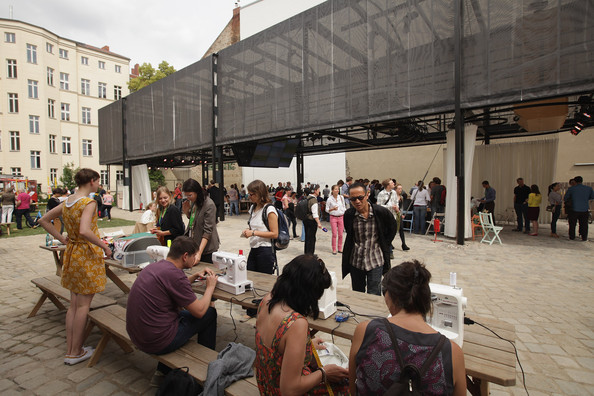Temporary Architecture & Architecture for the Temporary
After ample time to reflect on this, the final lecture in the Guggenheim series, I sat down tonight to read my notes and write this post.
What stands out for me is not the images that were shown--most of the slides were shotgun fast; there was no lengthy discussion of specific projects--but the final discussion about where we leave room in the city for temporary architecture to occur. I thought that this tied nicely into something I wanted to say about the Guggenheim Lab and lecture series in general, including the difficulties it faced in finding a spot in Berlin to take over for the weeks it was here.
What is Temporary Architecture?
> Temporary architecture can be defined as any space that is mobile or intended only to be used for a short period of time before it is either dismantled or relocated. The effects of temporary architecture can be measured by the effect they have on the community they enter, e.g.
- music festival beginning
- circus coming to town
- "Shakespeare in the Park" beginning
> Temporary architecture is often responsive and adaptable to function and location. The structures are about tectonics and often act as a testing ground for new technologies without the pressure of lasting permanently.
> Temporary architecture sometimes takes the form of life-saving design, like earthquake relief structures or refugee camps. It can offer a sense of place for people without a status and a sense of continuity when there aren’t any permanent structures.
Temporary architecture because permanence would be a nuisance
Olympic games are infamous for leaving behind what are known as “white elephants” – huge mega structures that are only ever used to capacity a few times during specific Olympic events, cost an enormous amount of money to build, and often stand empty after their few weeks in the spotlight.
To avoid such “white elephants” London made its Olympic bid based on the concept of having more temporary structures that could be recycled for sporting events in other locations afterwards. One of these structures is the shooting range, a structure designed by MAGMA Architecture. After the structure is disassembled it leaves nothing behind.
The structure is basically scaffolding material covered with a PVC membrane. Standard elements were used so it can easily be transported, assembled, and taken apart. The PVC skin can be fully recycled and is controlled by a series of tension rings that keep the structure tight, serve as ventilation, and also make a visual reference to the targets used in shooting.
Temporary architecture to facilitate community
In Linz, Austria, one of the major motorways was covered by a landscaped park. Two parts of the city that had been growing separately because of the division the highway made between them were suddenly reunited. To celebrate this reunion of the city, Fattinger Orso Architects created a temporary pavilion and a program of specific cultural activities to draw the public onto this new landscaped park.
Bellevue Temporary Pavilion, Fattinger Orso Architects
The intention of the structure was to re-introduce the two neighborhoods and after hosting artist installations it was disassembled and recycled. Its short life made the architecture a special event in the minds of the community, and served as a catalyst for other cultural programs to take place in the park.
Architecture for the Temporary
There is a difference between temporary architecture and architecture for the temporary.
Metropol Parasol, J Mayer H Architects
Metropol Parasol by J. Mayer H. in Seville completely activated parts of Seville that didn’t know they needed a space like this. The umbrella provides shade while marking the museum entrance underground. On the street level in between, hundreds of temporary events are perfectly housed. This is a piece of architecture that attracts events to it. Gay pride, Semana Santa, the Occupy movement, the Euro-Cup victory… all these events are now centered in the area of the Metropol Parasol.
I'm skipping Teddy Cruz's lecture because I didn't understand a goddamned word of it. His website is equally opaque.
QUESTIONS FOR THE PANEL
1. How do you design with the communities who will be affected by the design in mind? In other words, how do you consider the temporality / ephemerality of the neighborhood itself when designing?
You can try to design an anticipatory space, but it’s probably better to center the design of a temporary building on a specific program on offer that reacts to the needs and issues of the community. Being on site is very important to get the sense of what is needed in the area.
2. Right now we have to face things like archaic zoning laws that prevent us from planning for temporary events. At the same time, certain areas that are zoned for something and haven’t been built on yet for lack of investment could provide an opportunity for interesting temporary architecture. Could this conflict become generative?
The way zoning / financing works doesn’t function at the micro-scale. We need to rethink these policies so they function as enablers rather than disablers. For example allowing small additions and enabling density in terms of social exchanges.
My thoughts:
Basically there is the understanding among designers and architects that current zoning regulations prevent certain parts of the city from becoming vibrant, mixed, and dense. I totally agree with this, but I also feel that no one is advocating the right people to change this. It is not really about advocating the government to change their zoning restrictions... rather, the desire to separate functions comes from the community itself.
It is one of the responsibilities of architects and designers to show the community how well different functions and diverse use can work together, and how it can actually improve the value of their neighborhood. After all, the things that make European cities characteristically pleasant to be in--lots of urban life, easy access to small shops and services, pocket parks, good public transit, and apartment living--are the very things that most North American homeowners want to avoid.
I think there are several reasons for this attitude (among them the ingrained idea that everyone should own land) but the most compelling reason is the safety factor. There is a conception that if you concentrate too many people in one area you will generate crime and encourage havoc.
It often takes time for people to come to terms with the value that diversity can bring to a city. That is where temporary architecture could be used--to bridge a gap in public perception.
There’s the example in Berlin of the Prinzessinnengarten at Moritzplatz. This was an empty lot for many years, zoned for mixed residential and commercial use in an area with (at the time) a surplus of housing. The lot was taken over a few years ago and has turned into a famous urban community garden with a café, stage, and weekly market. Since it would be against the law to lay any permanent structures on the site, all the gardens are in raised beds or open containers (milk crates, paper bags, shipping pallets).
This garden has transformed attitudes, not just in Berlin but worldwide about the value of urban farming, community gardens, and the possibility for setting up productive space in unproductive/unused lots. The garden has become an established public space in the city and it is successful because it brings value to the whole neighborhood. [as a side note, the garden is under threat for the land to be sold to a developer, you can sign the petition to stop this on their website.]
3. Temporary architecture was constantly produced in the past but it was a subversive type of architecture, usually alongside some permanent structure (squats, favelas, or slums beside a resort or factory where the people living in slums would work). If temporary architecture is functioning as subversive what is the point in planning for it?
The answer to this segues into a final thought I have on the Guggenheim Lab in general.
The Guggenheim Lab was a temporary space itself, an outdoor lecture hall that traveled from city to city to hold free lectures, discussions, and workshops for a few weeks. These discussions activated both the neighborhood surrounding the space and the design community to think about all kinds of problems facing urban areas today.
Maybe you aren’t aware, but the GLAB had a lot of problems in finding a space to situate in Berlin. I'm not 100% clear on the reasons why due to my limited capacity for reading translated newspapers online, but here's my impression. Originally it was slotted to sit on the edge of Kreuzberg, on an empty lot near to a famous squat. However the people of Kreuzberg protested and made such a stink about the ever prevalent "rising cost of rent" and "disrespect to the altwohner" (old houses) (um, i.e., squats?).
Eventually GLAB decided to move into the old Pfefferberg brewery area in Prenzlauer Berg (which was not without issue either).
The Guggenheim Lab Pavilion in Prenzlauer Berg. Surprisingly, no one died or suffered financially from the 'intrusion.'
How very terrible!! The community... engaged in DISCUSSIONS and WORKSHOPS! HORRORS!
GLAB fit in very well between the old brick buildings at Pfefferberg. 2 months of exhibitions, round-tables, awards presentations and free lectures later, you can’t even see a trace of the temporary facilities--the black box you see above which provided an outdoor lecture hall for events--but the impact of this lab is huge.
The point is: when temporary architecture is done well, people want to keep it. It brings people together and has a lasting impression. The garden at Moritzplats is one example. The G-LAB is another.
The uptight community of protesting squatters in Kreuzberg does the opposite. They drive people away because their view of community involvement is strictly shaped by the desire to uphold their neighborhood in its exact form. They are living with a very limited understanding of 'community' and what it means to support forums that think differently from themselves. They coan't imagine what the Kreuzberg was like before they were there, and they have no imagination to see what it could be in the future.
To these people, Berlin should be left untouched. What they don’t understand is that they are making the city a relic, and a relic is lifeless. It’s not going to take long before the buildings that are being squatted in decay to the point where nothing will be left. What does all that ‘subversion’ stand for in the end?




